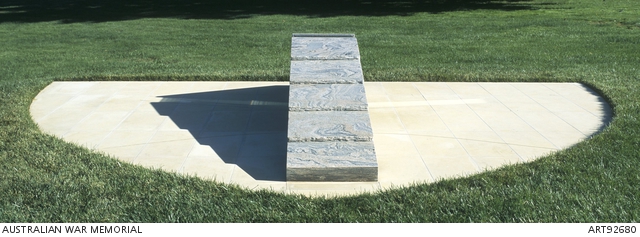| Place | Asia: Borneo, North Borneo, Sandakan |
|---|---|
| Accession Number | ART92680 |
| Collection type | Art |
| Measurement | Overall: 74.5 x 660 cm x 427.5 cm |
| Object type | Sculpture |
| Physical description | granite (Juparana Columbo), sandstone, glass |
| Location | Main Bld: Outdoor Exhibition Area: Western Precinct |
| Maker |
Ferguson, Anne |
| Place made | Australia: New South Wales |
| Date made | 2005 |
| Conflict |
Second World War, 1939-1945 |
| Copyright |
Item copyright: © Australian War Memorial This item is licensed under CC BY-NC
This item is licensed under CC BY-NC
|
Sandakan memorial







The Sandakan memorial is a sculpture commissioned by the Australian War Memorial to acknowledge and remember those who died during the Sandakan death march, Borneo in 1945 . The work is installed in the Memorial's sculpture garden. Designed as an accurate sundial, the memorial is rich in symbolism. The shape of the stone, with four steps carved in one side to represent the number of years spent in captivity, was inspired by the airfields the prisoners were sent to construct. Similar to that found in the Sandakan region, the swirling patterns in the granite recall the winds and mountains of Borneo, 'the land beneath the wind'. The sundial marks the passage of time, and evokes our remembrance of the past and of lives cut short. Engraved lines trace the shadows cast on the summer and winter solstices (the outer lines) and on Remembrance Day (the inner line). The sculpture has been commissioned in memory of the 1,787 Australian prisoners of war who died in the Sandakan death marches, in Borneo, in the final months of the Second World War. Only six survived this atrocity. Ferguson's memorial is made of granite (Juparana Columbo), sandstone and glass. As a sundial, the memorial refers both to the passage of time and to our remembrance of the past. Engraved lines trace the shadows cast on 11 November and the summer and winter solstices. Sunlight reflected through the glass cuts across these lines, symbolising lives cut short.
After the fall of Singapore and Borneo to the Japanese, a prisoner of war camp was established just outside of Sandakan in Borneo, to house approximately 750 British and more than 1,650 Australian prisoners who were sent to the camp during the period 1942-43. In 1945, when the Japanese started to realise that the war may have been lost, and the Allies were closing in, the emaciated prisoners were force marched, in three separate marches, to the village of Ranau in the jungle, 250 km away, under the shadows of Mount Kinabalu. On 28 January, 1945, 470 prisoners set off, with only 313 arriving in Ranau. On the second march, 570 started from Sandakan, but only 118 reached Ranau. The third march which comprised the last of the prisoners from the Sandakan camp contained 537 prisoners. Prisoners who were unable to walk were shot. The route traversed virgin jungle infested with crocodiles, snakes and wild pigs, and some of the prisoners had no boots. Rations were less than minimal. The march took nearly a year to complete. Once the surviving prisoners arrived in Ranau, they were put to work carrying 20 kg sacks of flour over very hilly terrain to Paginatan, over 40 km away. By the end of July, 1945, there were no prisoners left in Ranau. Only six Australians of the 2,400 prisoners survived what has become known as the "death march". They survived because they were able to escape from the camp at Ranau, or escaped during the march from Sandakan. No British prisoners survived.